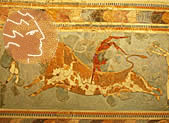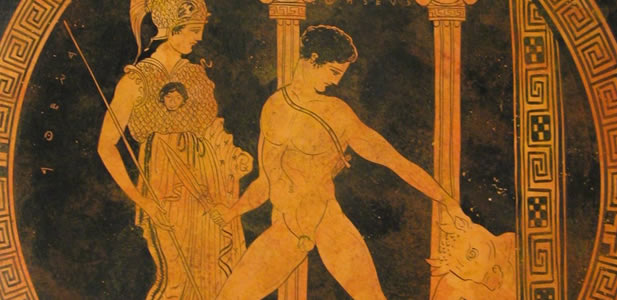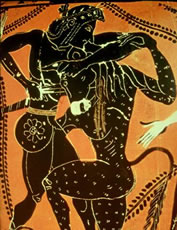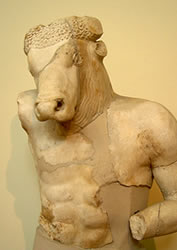








Theseus and the Minotaur
Minoan Toll
Cretan King Minos son Androgeus won an event in the sacred games in Athens, the Panathenia. This was during the period of Aegeus in Athens before the birth of his son, Theseus. Androgeusíjealous opponents killed him before he could win any more games. A second version of the myth says that Androgeus got killed fighting the bull of Marathon which Theseus killed later on.
Convinced that his son was murdered, King Minos launched a powerful fleet against Athens.He took over Megara but unfortunately not Athens.His father Zeus wanted to please him in his despair however and caused plagues and hunger upon Athens.
To survive Athens was demanded a heavy toll: seven youths and seven maidens had to be sacrificed to the minotaur the monster bull which lived in the depths of the complicated labyrinth, the work of the master craftsman Daedalus, which once entered was impossible to get out and would be at the mercy of minotaur.
The Minotaur
The minotaur was the offspring of the union between Pasifai (wife of Minos) and a bull. Poseidon sent the bull emerging from the sea to Minos signifying his dominance over the whole of Crete. Poseidon requested Minos to sacrifice the bull in his honour but the latter did not oblige.Poseidonís anger took on a nasty turn-he provoked the desire of Pasifai to make passionate love to the bull. Naturally this wasnít easy.Alas our multi-talented craftsman Daedalus comes to the rescue again!He builds a wooden effigy of a cow,hollow inside for Pasifai to fit in and covers the exterior with real hide from a freshly slaughtered cow and wheels the effigy with the woman into the valley where the bull was grazing.The minotaur was the product of this unnatural mating : a monster with the head of a bull and the body of a man. Minos locked up the monster in the depths of the labyrinth and fed it with human blood.
When it was due to pay the bloody toll for the third time to Minos, Theseus asked his father to be included in the party of the would-be victims who were chosen by a drawing. Theseus thus volunteered his life.
A ship with black sails departed for Crete carrying the would-be victims with the promise that on its return it would wear white sails instead signifying success and the release from this heavy burden.Upon arrival an intense argument ensues between Minos and Theseus in which the latter claims that he too is the son of the god Poseidon.To prove it he accepts the challenge of Minos who throws his ring in the sea for Theseus to retrieve.While in the sea Aphrodite welcomes him and gives him a red cloak and a crown of roses and leads him to the palace of the gods. Theseus returns from the deep triumphantly with the ring , proving his divine ancestry.
The Labyrinth and Aridne's clue
Theseus finds an ally in Ariadne, daughter of Minos and Pasifai, who falls in love with the young handsome royal prince from Athens. Ariadne offers her help, in return he promises to take her with him and marry her. In the labyrinth Theseus had to first kill the minotaur and then find his way out.The latter could be solved by one man only-the inventor himself: Daedalus!
Ariadne immediately consulted him and he proposed a clever trick:Whoever goes into the labyrinth must take a ball of thread with him.Tieing it somewhere at the front of the labyrinth then he would proceed while unwinding the thread behind him.On his return he would rewind the thread into a ball again thereby exiting the labyrinth more easily. Theseus followed Daedalusí advice. It is said that Ariadne held the thread at edge of the labyrinth waiting for the return of her lover-hence the saying : Ariadneís clue.
Meanwhile Theseus comes face to face with the minotaur and fights it and kills it with his sword, offers it to Poseidon which Minos had promised but did not do before.
The myth of the minotaur is associated with the myth of the creator of the labyrinth- Daedalus!
The Return to Athens
After the defeat of the minotaur Theseus and Ariadne leave Crete with the same ship he came in with.Their first stop was at the island of Naxos where with the union of their love produced two sons : Dimofontas and Akamantas both of whom took part in the Trojan war or according to another source their names were Stafylos and Inopionas.
According to one legend this was the last time they were together, because as the pair slept the godess Athena appears in Theseusí dreams instructing him to abandon Ariadne. Others maintain that it was another beautiful girl who had caught Theseusí attention when he was in Athens called Aigly.A final version concerning the destiny of the pair is that the god Dionysos also had eyes for Ariadne and could not bear to see her at Theseusíside and abducted her, cajoled her and giving her a golden wreath finally persuading her to stay with him.
The biggest labour of Theseus ended in tragedy. On his return from Crete he forgot to change the black sails to white. At the sight of this Aegeus believing that his son was indeed fed to the minotaur, in his desperation flung himself on the rocks at cape Sounion. Thatís why the sea there is named ĎAegeon PelagosĒ.
Minoan Toll
Cretan King Minos son Androgeus won an event in the sacred games in Athens, the Panathenia. This was during the period of Aegeus in Athens before the birth of his son, Theseus. Androgeusíjealous opponents killed him before he could win any more games. A second version of the myth says that Androgeus got killed fighting the bull of Marathon which Theseus killed later on.
Convinced that his son was murdered, King Minos launched a powerful fleet against Athens.He took over Megara but unfortunately not Athens.His father Zeus wanted to please him in his despair however and caused plagues and hunger upon Athens.
To survive Athens was demanded a heavy toll: seven youths and seven maidens had to be sacrificed to the minotaur the monster bull which lived in the depths of the complicated labyrinth, the work of the master craftsman Daedalus, which once entered was impossible to get out and would be at the mercy of minotaur.
The Minotaur
The minotaur was the offspring of the union between Pasifai (wife of Minos) and a bull. Poseidon sent the bull emerging from the sea to Minos signifying his dominance over the whole of Crete. Poseidon requested Minos to sacrifice the bull in his honour but the latter did not oblige.Poseidonís anger took on a nasty turn-he provoked the desire of Pasifai to make passionate love to the bull. Naturally this wasnít easy.Alas our multi-talented craftsman Daedalus comes to the rescue again!He builds a wooden effigy of a cow,hollow inside for Pasifai to fit in and covers the exterior with real hide from a freshly slaughtered cow and wheels the effigy with the woman into the valley where the bull was grazing.The minotaur was the product of this unnatural mating : a monster with the head of a bull and the body of a man. Minos locked up the monster in the depths of the labyrinth and fed it with human blood.
When it was due to pay the bloody toll for the third time to Minos, Theseus asked his father to be included in the party of the would-be victims who were chosen by a drawing. Theseus thus volunteered his life.
A ship with black sails departed for Crete carrying the would-be victims with the promise that on its return it would wear white sails instead signifying success and the release from this heavy burden.Upon arrival an intense argument ensues between Minos and Theseus in which the latter claims that he too is the son of the god Poseidon.To prove it he accepts the challenge of Minos who throws his ring in the sea for Theseus to retrieve.While in the sea Aphrodite welcomes him and gives him a red cloak and a crown of roses and leads him to the palace of the gods. Theseus returns from the deep triumphantly with the ring , proving his divine ancestry.
The Labyrinth and Aridne's clue
Theseus finds an ally in Ariadne, daughter of Minos and Pasifai, who falls in love with the young handsome royal prince from Athens. Ariadne offers her help, in return he promises to take her with him and marry her. In the labyrinth Theseus had to first kill the minotaur and then find his way out.The latter could be solved by one man only-the inventor himself: Daedalus!
Ariadne immediately consulted him and he proposed a clever trick:Whoever goes into the labyrinth must take a ball of thread with him.Tieing it somewhere at the front of the labyrinth then he would proceed while unwinding the thread behind him.On his return he would rewind the thread into a ball again thereby exiting the labyrinth more easily. Theseus followed Daedalusí advice. It is said that Ariadne held the thread at edge of the labyrinth waiting for the return of her lover-hence the saying : Ariadneís clue.
Meanwhile Theseus comes face to face with the minotaur and fights it and kills it with his sword, offers it to Poseidon which Minos had promised but did not do before.
The myth of the minotaur is associated with the myth of the creator of the labyrinth- Daedalus!
The Return to Athens
After the defeat of the minotaur Theseus and Ariadne leave Crete with the same ship he came in with.Their first stop was at the island of Naxos where with the union of their love produced two sons : Dimofontas and Akamantas both of whom took part in the Trojan war or according to another source their names were Stafylos and Inopionas.
According to one legend this was the last time they were together, because as the pair slept the godess Athena appears in Theseusí dreams instructing him to abandon Ariadne. Others maintain that it was another beautiful girl who had caught Theseusí attention when he was in Athens called Aigly.A final version concerning the destiny of the pair is that the god Dionysos also had eyes for Ariadne and could not bear to see her at Theseusíside and abducted her, cajoled her and giving her a golden wreath finally persuading her to stay with him.
The biggest labour of Theseus ended in tragedy. On his return from Crete he forgot to change the black sails to white. At the sight of this Aegeus believing that his son was indeed fed to the minotaur, in his desperation flung himself on the rocks at cape Sounion. Thatís why the sea there is named ĎAegeon PelagosĒ.
